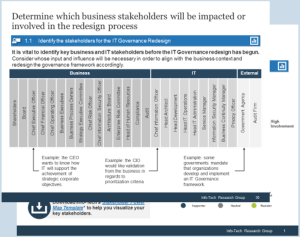What Strategies Can a CIO Advisory
IT governance is essential for ensuring that technology solutions align with enterprise strategy and are able to keep pace with the speed of business. However, traditional IT governance frameworks are being challenged by the digital era and need to be refreshed in order to stay current with rapidly evolving technology.
A CIO advisory can help with this process by guiding a new IT function through the initial establishment of its governance, structure and strategy or in a case where there are growing pains affecting an existing IT function that is already mature enough to require only some tweaking. This is not an admission of failure on the part of the IT team but a recognition that they can achieve greater integration with the business with the support and guidance of a CIO Advisor.

For example, the University of Kansas has used a CIO Advisor to assist with its IT governance framework redesign project that started last year. The university wanted to make sure its IT governance structures are up to date and can keep up with the changing needs of the enterprise.
What Strategies Can a CIO Advisory Employ to Enhance IT Governance?
It also wanted to ensure its IT teams have the right skills and capabilities for managing emerging requirements and that IT is able to work quickly and be secure while staying aligned with strategic business objectives. The redesigned IT governance framework has already led to significant changes, including a 30% reduction in the time it takes for requests to be processed and decisions made; an increase in the number of IT projects that meet or exceed their expected ROI; and a 20% improvement in IT alignment with business objectives.
A key component of the IT governance framework redesign project was establishing an information management plan for the organization. The university’s information governance policies are meant to set user boundaries around data access and control, which supports the organization’s business goals while keeping the integrity of its confidential data.
The project team also worked to determine if there is duplication of IT systems at the agency, shared service or enterprise level, which can lead to inefficient deployment of resources. The project has helped the university reduce system duplication and rework, as well as provide better service to its students and faculty.
While some leaders may think that IT governance slows down innovation and implementation, Gulzar and others argue that it actually speeds things up by enabling IT to be more agile. For example, a CIO advisory can help an IT function establish a decision-making authority model that ensures approvals can be quickly made at the right level of expertise. This allows IT to move faster without having to wait for a committee or board to make the decision.
A CIO advisory can also help with other IT governance processes, such as risk assessment and mitigation. It can develop and implement best practices for addressing business risks related to cybersecurity, physical damage, financial loss or regulatory compliance issues. It can also help an IT function define the key metrics that management will need to track in order to assess whether IT is meeting its responsibilities.